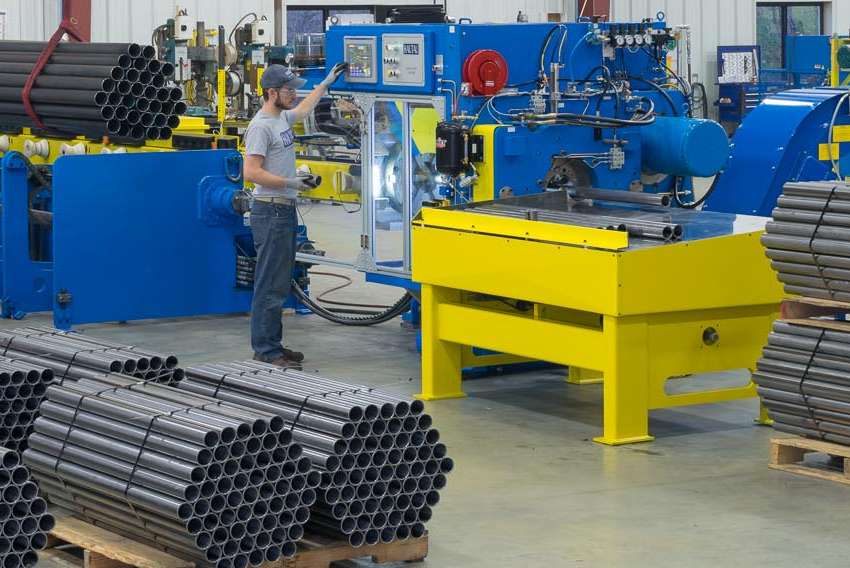The term “bottleneck” refers to a slowdown or stoppage in any production process. In tube cutting, bottlenecks typically occur at certain points on the production line. In order to fix these problems, it is important for planners to understand how their process becomes bottlenecked in the first place and what steps will solve the situation.
Finding and Fixing Production Bottlenecks
The automatic tube cutting process has several points where bottlenecks are likely to occur, including:
- Long setup or changeover times for different product sizes. Many older systems require manual changes to alter length stops or cutoff tooling. Every time a pipe diameter or length changes, the operator must stop, manually change the settings on the machine, load the stock, and cut. This can cause significant delays in production time, particularly when an order involves a wide range of sizes.
The Fix: New CNC tube cutoff machines help remove this type of bottleneck because they feature automatic changeover for both diameter and length. The stock can be loaded once and the cutting specifications changed as often as needed with the touch of a button.
- Lack of operator training. High employee turnover and significant training costs have led some owners to cut corners on employee training. A typical workaround is for employers to train an employee specifically to operate only one type of process. This means shorter training time, but the downside is that when an employee is out or leaves, that process may slow down significantly, as there are no replacement workers.
The Fix: New high-end production tube cutting machines require more initial operator training, but this time and effort pays off in having a few, highly-skilled workers who can handle almost any production run. Further, new machinery often offers both online, remote training courses as well as live assistance using the machine’s touchscreen interface. This means that any operator who is trained to use the machine can get instant access to support to run any type of cutting specifications.
- Loading and unloading delays. One of the most common bottlenecks involves tube loading or unloading. In older systems, the entire production line must be halted in order to load new material or to unload the finished product. This can lead to significant downtime along the entire production route.
The Fix: Rearranging tube bundle storage so that the materials are closer to the machine can help with this type of delay, and also consider using special side-loading fork trucks to move tube bundles. Depending on the application, adding a double-side loader may also help speed up loading of tubes. Offloading can be made more efficient with the help of an automated offloader that quickly sorts outgoing product so that it can be removed and transported.
- Rapid tool wear. If cutoff feed rates and cutoff tools are not correct for the material being processed, it may result in unnecessary delays in production. Nothing slows down a run faster than having to stop to replace tools or parts that are damaged due to incorrect use. This can also drive the cost of production up quickly.
The Fix: Ensure that the correct feed rates and tools are being used given the particular material. There should also be periodic checks to be sure that adequate lubricant is used on the tools to prevent damage. Newer machines also feature tool condition monitoring software that alerts operators when it is time for a tool change. Using a preventative tool life program that is monitored continuously will prevent many tool mishaps.
- Unscheduled maintenance. Stopping for unscheduled cleaning or maintenance eats away at overall production time. In most cases, these unscheduled stops add up to higher overall production costs, even if the problem can be fixed easily.
The Fix: Establishing a preventative maintenance program will do much to alleviate these problems. Having a periodic schedule for cleaning, inspection and regular service will minimize downtime and keep machines in good working order.
- Monitoring machine uptime. Older systems generally do not have built-in data-logging capabilities, so it is difficult to evaluate the overall efficiency of the system. Without this type of feedback, owners are often left in the dark about how well their systems are working.
The Fix: Purchasing a newer CNC tube cutting machine allows owners to use screen displays showing production history and uptime. These software systems can also find hidden delays due to changeovers, tube loading and machine faults. The data can be gathered and shared at the plant network level with managers, operators, production and maintenance groups to help optimize the overall production process. Most machines have very user-friendly interfaces that use multi-colored lights to indicate where the process is slowing down or idling, making spotting these issues easy.
At Hautau, we have spent decades developing some of the world’s finest CNC tube cutoff machines. Give us a call today to learn more about how we can make your production faster and more efficient.


